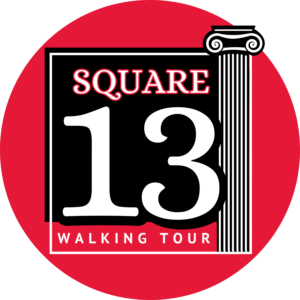Description

Lancaster’s Square 13 Historic District was listed on the National Register of Historic Places in 1983. It is one of six historic districts in Downtown Lancaster that feature the central business district of Lancaster, including most of the original town as it was laid out in the early 1800s. In the approximately one-block area of Square 13, visitors can see absolutely stunning historic homes and buildings that were built in more than a dozen diverse architectural styles.
Click here to explore this trail or download the free Visit Fairfield County app to listen to an audio tour.
History of Square 13
In 1796, at the suggestion of Governor Arthur St. Clair, Congress determined to have a roadway built through a section of the vast and sparsely settled Northwest Territory. Ebenezer Zane and his brother Jonathan and son-in-law John McIntire, hunters, scouts, and prospectors, were engaged to blaze a trail across the country from Virginia (now Wheeling, WV) to Limestone, Kentucky.
For this service, the Zanes were to receive three square miles of land, one each on the Muskingham, the Hock-hocking, and the Scioto Rivers.
Completion of the Congressional assignment resulted in the trail known as Zane’s Trace. Ebenezer’s sons, Noah and John laid out the town of New Lancaster in 1800 on the Hockhocking River and began to sell lots. Several lots were given free to fine craftsmen to encourage their settlement in the area. Work progressed so rapidly that by the spring of 1801 streets and alleys in the central part of town assumed the shape they still retain. By the 1820s the population of Lancaster was 2000, a great number of whom were well-educated young men whose enterprises of all kinds, both commercial and professional, flourished. To build homes that reflected the success of their ventures and their young city, they were fortunate to find here master builders from the East and from Europe whose buildings still stand today to attest to their knowledge of style and expert craftsmanship.
Square 13, a National Register Historic District, is one of the original blocks of Lancaster. This block has been called by many architectural historians, one of the finest collections of 19th-century architecture in a concentrated area in the nation.
As you walk around Square 13 you may wish to note recurring elements in its architecture; locally quarried sandstone in high retaining walls, double stone steps, lintels, foundation; bricks burned from local clay; iron fences cast in early local foundries; and woodcarving details in doorways, fanlights, cornices, and columns.
The architecture of this area, and Fairfield County as a whole, is a mixture of many influences adapted to this location.
The buildings of Square 13 often show a transition between styles, with architectural elements patterned after Asher Benjamin’s handbooks and other handbooks available to local builders.



















